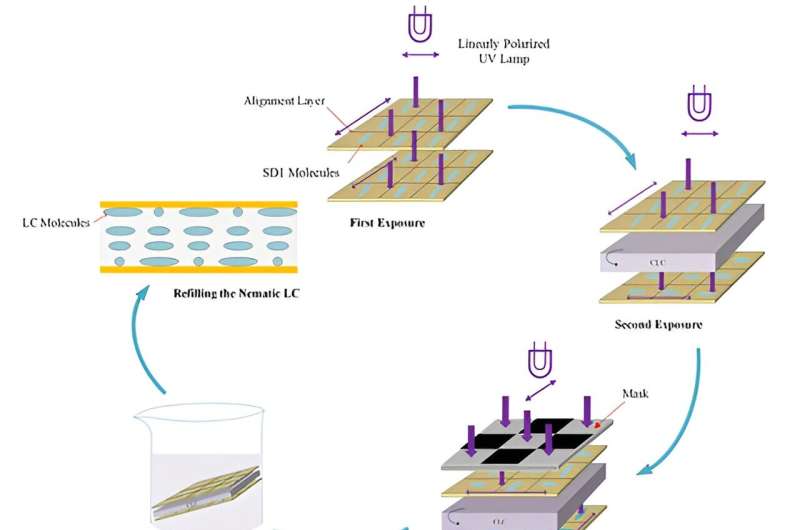This article has been reviewed according to Science X's editorial process and policies. Editors have highlighted the following attributes while ensuring the content's credibility:
fact-checked
trusted source
proofread
Researchers develop a new approach to polarization-independent LC phase modulation

Liquid-crystal (LC) phase modulators are widely used in optical systems because of their advantages of low power consumption, lightweight, flexible bandwidth adjustment, and non-mechanical movements. However, most LC phase modulators are polarization-sensitive, meaning that they affect the light phase differently depending on its polarization. This can limit their performance and functionality in some applications.
There are two main approaches to realizing polarization-independent LC phase modulators. The first approach uses polarization-independent LC materials, such as polymer-stabilized blue-phase liquid crystals (PS-BPLCs). However, PS-BPLCs require high driving voltages, making them impractical for some applications.
The second approach is to change the alignment of the LC directors. One way to do this is to use a double-layer LC cell, which consists of two LC cells stacked on top of each other with their LC directors oriented orthogonally. This allows light to be decomposed into two orthogonal components, each of which experiences the same phase modulation. However, double-layer LC cells are complex and difficult to manufacture.
Another way to achieve polarization-independent LC phase modulation is to use orthogonal photoalignment. This involves using a special photoalignment layer that creates orthogonal alignment domains in the LC. However, it is difficult to achieve precise alignment using this method.
In a new paper published in Light: Advanced Manufacturing, a team of scientists led by Professor Jiangang Lu has developed a new approach to polarization-independent LC phase modulation.
Polarization-independent LC phase modulation is based on a light-controlled azimuth angle (LCAA) process. The LCAA process uses the optical rotatory effect of cholesteric liquid crystals (CLC) to create single-layer, multi-microdomain, orthogonally twisted (MMOT) structures.
MMOT structures are composed of multiple microdomains with orthogonally aligned LC directors. The LCAA process uses a patterned light beam to control the alignment of the LC directors in each microdomain. This allows the researchers to create MMOT structures with precise alignment.
LC phase modulators with a single-layer MMOT structure have the potential to be both polarization-independent and have a large phase depth. This makes them ideal for various applications, including optical communications, wearable devices, and displays.
A light-controlled azimuth angle (LCAA) process can be used to fabricate a multi-microdomain orthogonally twisted (MMOT) device with low polarization dependence, high phase retardation, and a simple structure. The alignment angle between the top and bottom substrates in the LCAA process and the mask grid size of the MMOT structure can be tailored to meet the requirements of different applications.
This device has the potential to revolutionize the way we use light in various applications. For example, it could be used to create new types of optical communications systems that are more efficient and reliable. It could also be used to develop new types of wearable devices that can display information in a more clear and concise way.
More information: Mingyuan Tang et al, Polarization-independent liquid-crystal phase modulator with multi-microdomain orthogonally twisted photoalignment, Light: Advanced Manufacturing (2023). DOI: 10.37188/lam.2023.035
Provided by Chinese Academy of Sciences




















